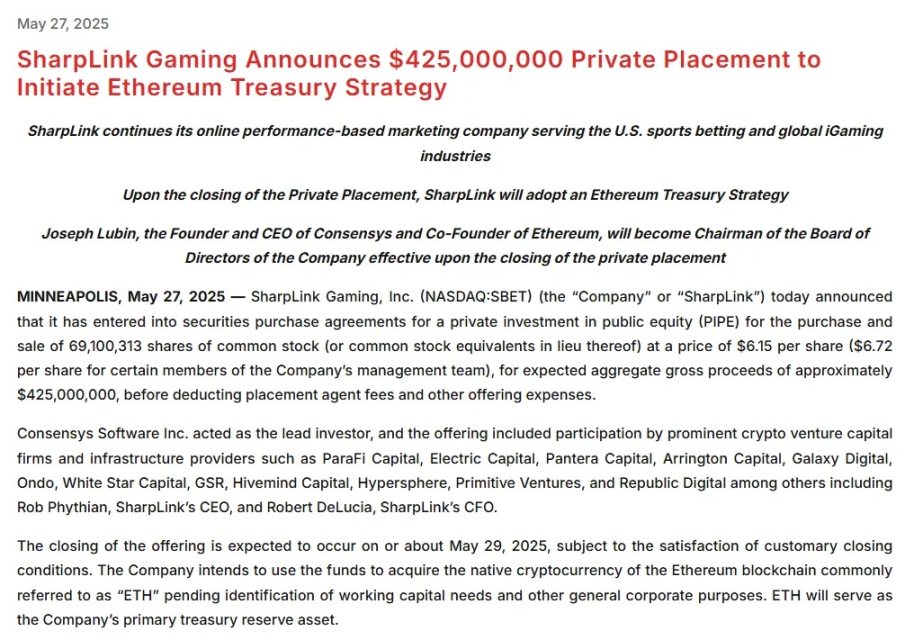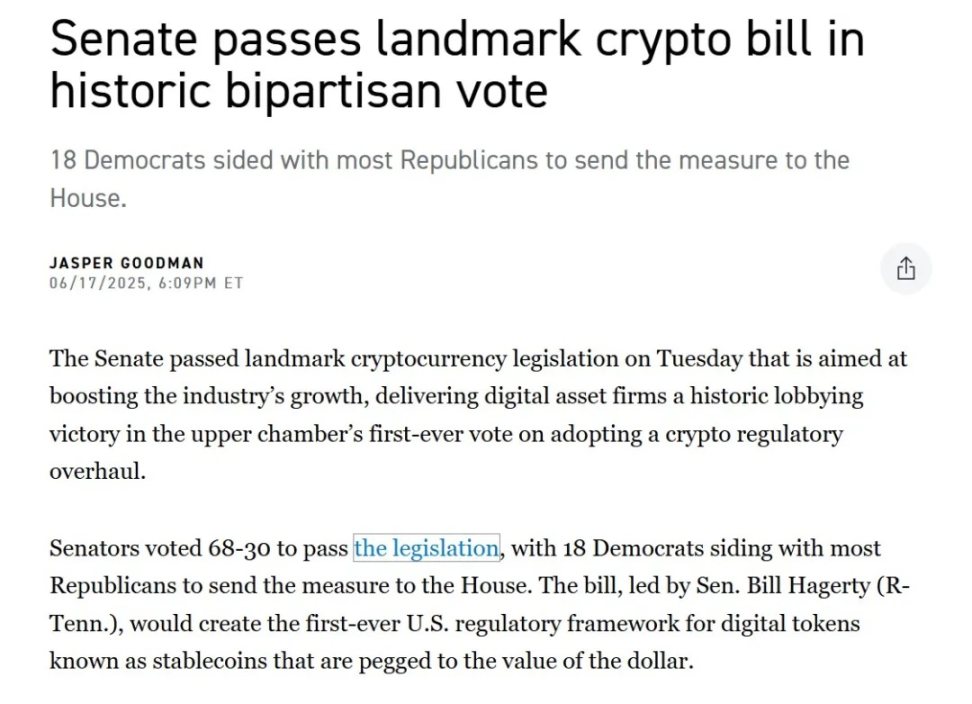From the financial exposure of BTC/ETH to the reconstruction of on-chain payment networks, and the actual influence on crypto regulations, institutions are gradually reshaping the foundation of the Web3 world.
Written by: Imtoken
The crypto world is welcoming a familiar and powerful force.
In the early hours of June 18, Beijing time, the U.S. Senate passed the "GENIUS Act," hailed as a milestone in crypto payment legislation, with 68 votes in favor and 30 against. This not only means that stablecoins are officially included in the financial regulatory system for the first time in federal law but also symbolizes that the crypto industry is accelerating into the fast lane of institutionalization and mainstream adoption.
In parallel, a number of traditional financial giants and publicly listed companies are moving from "exploratory trials" to "deep embrace": some are publicly incorporating on-chain assets into their financial statements, some are diving into the stablecoin battle, and others are building their own on-chain payment channels and financial account systems.
This article will summarize the recent actions of TradFi giants and traditional institutional players in the crypto space, outlining a panoramic view of the institutional entry era in Web3 from three aspects: asset allocation, stablecoin competition, and policy turning points.
01 "MicroStrategy" Heat: Crypto Flooding into Balance Sheets
When it comes to "institutional entry," Strategy (formerly MicroStrategy) is almost an unavoidable classic example.
As a super supporter of Bitcoin, Strategy first announced its purchase of Bitcoin in August 2020 and has since embarked on a path of continuous accumulation.
As of June 15, 2025, Strategy has purchased approximately 592,100 Bitcoins for about $42 billion, with an average price of about $70,666, leading not only among U.S. public companies but also ranking high among global Bitcoin-holding entities.

This strategy has also caused Strategy's stock price to be almost highly correlated with Bitcoin, being referred to by the market as a "substitute for a Bitcoin ETF in U.S. stocks." However, what is more noteworthy is that a number of emerging companies are replicating this path, sparking a wave of "Strategy-like models":
- SBET (SharpLink Gaming): Transitioning from an iGaming marketing platform to an Ethereum-native asset allocation platform, receiving investments from top crypto VCs like ParaFi and Pantera, and announcing the adoption of the "Ethereum Treasury Strategy";
- EYEN, DFDV, SRM, etc.: Establishing financial exposure around HYPE, SOL, TRX, etc., becoming "crypto mapping stocks" favored by retail investors;

These "Crypto mapping stocks," along with Circle and Coinbase, are sparking a wave of "Crypto × TradFi" concept speculation in U.S. stocks, reflecting a quietly forming trend: crypto assets are transitioning from "speculative assets" to "a part of public company balance sheets."
This also signifies a structural shift: digital assets are becoming an important component of institutional balance sheets, truly beginning to possess "allocation-level" status.
02 New Battlefield for Stablecoins: Who Will Print the "Next Dollar"
Another noteworthy institutional trend is that traditional financial giants and emerging players are flocking to issue stablecoins.
Whether it's the USD1 closely associated with Trump or the recently listed Circle (USDC), as the compliance process for stablecoins accelerates, a host of financial and tech giants are entering the fray to compete for dominance over the "new dollar."
The most direct manifestation is that several traditional giants are "personally entering the field" to issue or custody stablecoins in different ways:
- As early as 2023, PayPal launched the PYUSD stablecoin and gradually integrated it into its wallet and checkout processes;
- Recently, JPMorgan, which has had a fierce attitude towards crypto, officially submitted a trademark application for the "JPMD" stablecoin, indicating its intention to expand its private chain settlement capabilities to public chains and even international clearing systems;
- Visa and Mastercard have also been intensively promoting a full-process layout for stablecoins "from wallet to merchant" over the past two months, exploring the integration of stablecoins into credit card payment systems to build a complete on-chain payment path from wallet to merchant settlement;

This is naturally riding the wave of loosening or even encouraging compliance policies for stablecoins. It can be said that the battle for stablecoins has moved from crypto-native projects to the traditional financial giants' table.
In addition, thanks to the inherent advantages of stablecoins in cross-border trade and settlement, some originally non-financial giants are also beginning to explore stablecoins. For example, retail giants Walmart and Amazon are rumored to be researching the issuance of stablecoins, which could help them bypass traditional payment networks and save billions in fees.
Moreover, the recently reported JD stablecoin is expected to obtain a license by the end of 2025 and launch the JD stablecoin simultaneously, with the first issuance likely pegged to both the Hong Kong dollar and the U.S. dollar. As a Chinese e-commerce giant, JD's actions in the stablecoin space are attracting attention, representing not only a technological layout at the company level but also a deep transformation of international trade and supply chain finance.
From this perspective, in the coming years, stablecoins may replay the rise of credit card networks—first paved by giants, then supported by policies, and ultimately established as a standard in payments.
03 Starting with Stablecoins: Is Institutionalization Entering a New Cycle?
Looking back now, we can see that the institutionalization of crypto has already gone through years of dormancy and accumulation. As early as 2019, the emergence of Libra made many people exclaim about the arrival of the "digital dollar" era, but the ambition of this global payment system became almost the only highlight of Libra, which had to gradually scale back its goals and ultimately fade away under heavy regulatory pressure.
Nevertheless, Libra, to some extent, propelled the large-scale practical process of the "digital dollar" experiment, especially with the explosive growth of dollar-denominated stablecoins in 2020, which quickly penetrated into broader financial scenarios, becoming a dollar alternative for applications like cross-border payments.
Since last year, global market recognition of cryptocurrencies has surged, and the aforementioned "GENIUS Act" is a significant milestone. It can be said that another key factor accelerating institutional layout is the major shift in regulatory stance:
As a federal-level legislation focused on the issuance and management of stablecoins, it clearly states that stablecoin issuers must meet 1:1 reserves, audit reports, and redemption obligations, and supports banks, licensed institutions, and audited enterprises in applying for issuance qualifications, undoubtedly opening a compliance door for Wall Street's big players.

Therefore, before and after the clear expectations for the implementation of the bill, we have seen multiple changes accelerating—besides Circle's listing and impressive performance, JPMorgan, PayPal, and others have accelerated the compliance filing process for stablecoin products, and traditional asset management institutions like Franklin Templeton and Fidelity have initiated digital asset custody and re-issuance attempts.
If in the past stablecoins were the "folk hard currency" of the Web3 world, then compliant stablecoins may become the global currency replica in the next generation of financial infrastructure.
As demand from institutions and high-net-worth individuals rapidly grows, a purely trading business model can no longer meet the increasingly complex market demands. Non-trading business competition is becoming the strategic core under the new wave of institutionalization brought by institutions and giants.
04 Conclusion
From the financial exposure of BTC/ETH to the reconstruction of on-chain payment networks, and the actual influence on crypto regulations, institutions are gradually reshaping the foundation of the Web3 world. These traditional financial players are clearly not just testing the waters but intend to deeply cultivate the long-term industrial chain.
In the coming years, the landscape of the crypto industry may no longer be just a competition between "projects and protocols," but a reconfiguration of the map between crypto-native enterprises and financial giants.
This also means that the real narrative battle has just begun.
免责声明:本文章仅代表作者个人观点,不代表本平台的立场和观点。本文章仅供信息分享,不构成对任何人的任何投资建议。用户与作者之间的任何争议,与本平台无关。如网页中刊载的文章或图片涉及侵权,请提供相关的权利证明和身份证明发送邮件到support@aicoin.com,本平台相关工作人员将会进行核查。




